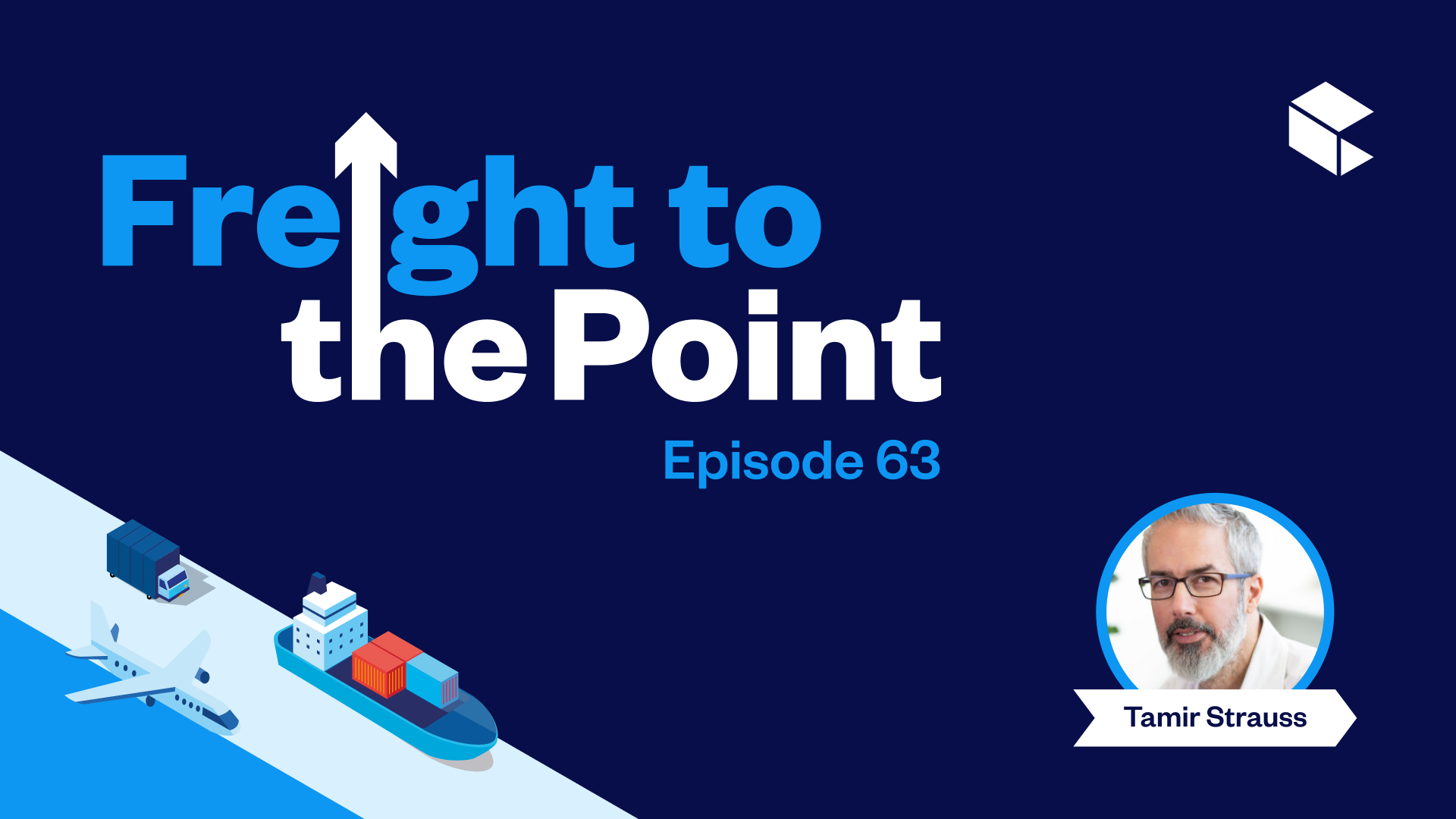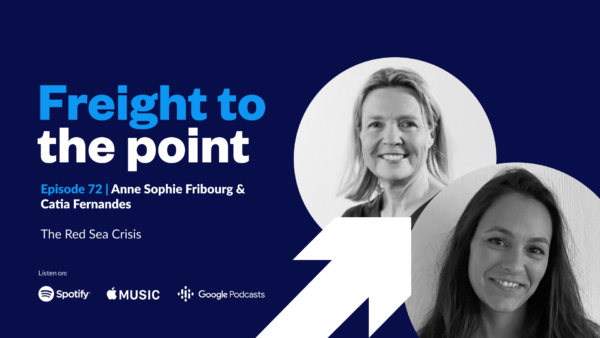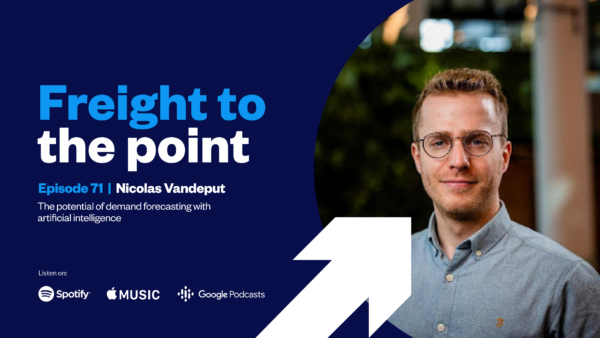Episode 63:
AI in the supply chain
See all episodes

As ChatGPT and other AI language models made significant progress this year, it has prompted all industries, including the supply chain, to think about how AI can drive efficiency.
In this podcast episode, Alex Hersham, Co-founder and CEO at Zencargo and Tamir Strauss, Chief Product and Technology Officer at Zencargo discuss the impact of AI on businesses and the supply chain. Tamir, who boasts an extensive career in the science and tech space, shares his insights on existing AI technologies that have been in use for a long time, such as OCR and robotic process automation.
They explore:
- How AI is being adopted by businesses to drive operational efficiency.
- How AI can revolutionise supply chain decision-making, especially in demand forecasting, inventory management, and optimising warehouse intake.
- How AI capabilities will evolve to help companies stay competitive and make data- driven decisions.
Tamir Strauss
Tamir has over 25 years of experience in product and tech, working with companies such as Huma and Snatch before joining Zencargo. Driven by analytical problem solving, strategic thinking and innovating Tamir’s goals focus on improving business processes.
Resources
Episode 3: Tamir Strauss and Priscilla Parrish on how to build a smarter supply chain
Alex Hersham:
Hi, everyone. Welcome to another episode of Freight to the Point. I’m Alex Hersham, your host, Zencargo’s CEO. And today I’m joined by a colleague of mine, Tamir Strauss, who’s our Chief Product and Technology officer.
Tamir, welcome.
Tamir Strauss:
Thank you. Good to be here.
Alex Hersham:
Tamir, you and I have spoken a lot this year about ChatGPT, about its implications for individuals for gaining knowledge, for being more hacky, for doing things faster. We’ve also spoken a lot about its implication for business. Whether it’s ChatGPT itself or large language models in general, the development in AI has been dramatic and it feels like we’re really at an inflection point.
I’m seeing loads of businesses start to adopt AI. I’m seeing it inside our business, in terms of how we market more effectively, in terms of our go-to-market strategies, in terms of how we operate more effectively and start to look at things. And of course, how our broader operating system in the supply chain is going to be affected and how supply chains more broadly are going to be impacted over the next couple of years is a key question that I’m so glad you’re here with me to answer.
Before we jump into the topic today, why don’t you give us a brief background on yourself?
Tamir Strauss:
I started my career many years ago as developer for the Israel Army actually and have been in technology ever since, taking on both leadership roles in engineering, but also in product, and mixing the two, as I’m doing at Zencargo. I’m a very keen follower of technology and science in general, so this is something that I’ve been following for many years now.
Alex Hersham:
Fantastic. I remember the first day that we met, just before COVID, and it’s been a great journey so far. With the recent surge in AI, and it’s happening across a variety of industries, and I think if you were to speak to the C-suite of the Fortune 500, you’d have more than 90% of those folks saying, yeah, we really want to focus in on AI. Has it started to trickle down to the supply chain?
Tamir Strauss:
I think because of the current climate, people are thinking of AI as a new thing, but it’s been around for ages. If we think of supply chain and many other industries that are similar to supply chain, you can think of OCR, which is basically machine learning, which is basically AI, that’s been around for ages. It’s getting better all the time, of course. But if you think of all the documents that you have to deal with, trying to convert them into something that it’s more structured and more easily to manipulate by machines, has been an effort that companies have been doing for probably a decade if not more. And connected to that is RPA, robotic process automation, and all the other things associated with these conversions of text or images or documents into something that we can do something with or use to manipulate.
If we think of tracking or the, more specifically, ETAs and predictions around that that, again, has been around for a couple years at least. It’s probably more.
Alex Hersham:
Yeah.
Tamir Strauss:
And using AI to optimise routes and various sort of thing. And probably the biggest area where AI has been used for a long time is the warehouses, where you have robotics, where you have automation, where you have computer vision and things that are happening automatically. All of that is based on machine learning and AI. I think we are doing it a bit of a disservice by focusing on the buzz that’s happening at the moment.
But I do believe that by having this noise being generated, companies are much more aware of the technology, generally, and therefore probably more keen to adopt it. Because now there’s a sense that if you don’t adopt it, you’ll be left behind, which is probably correct. Specifically ChatGPT and large language models, I think, would help definitely with communication, with obviously service, and all the aspects that are associated with that that cut across multiple industries.
I think we’ll see that coming into supply chain more forcefully than it was before. But it’s been around there for a long time, so I don’t think we should forget that.
Alex Hersham:
Yeah, 100%. I mean, we did a port tour of Rotterdam a couple of weeks ago, where we brought 20 or 30 of our clients and spent a day together. And you look at that infrastructure and you say to yourself, that has been leveraging AI for years. Of course it’s getting better and better and better, but these are almost large swathes of land that are completely unmanned. And it’s just incredible to see what’s happening.
There you spoke a bit about document reading, you spoke a bit about ETA accuracy. These are cool things, they reduce manual touch, they enrich other systems, it definitely improves. But what else are you seeing in terms of how AI is both improving efficiency, which is super important, but also improving decision-making, which I think is probably even more important when it comes to the supply chain?
Tamir Strauss:
I think all these technologies should be thought of as a combination of tools. The core of AI and everything that it does relies on data. If you have all this information, if you collect all that information, if you reflect reality, if you’re able to store the data in a way that is accessible to machine learning and AI, then you can start driving predictions and improvements in efficiency. Because your system can understand what’s happening now, can look at the past and draw conclusions from it and then drive predictions and decision and support, and to a large extent, in the not-too-distant future, I believe, automation as well. It could act on its own for many things. Obviously some things you would still want to have humans involved and asked, but generally speaking, I think less and less.
Alex Hersham:
And to what extent has the integration of AI already impacted traditional supply chains? I mean, we spoke about a few examples there, but at the customer level or at the freight forwarder level, are we seeing things today that we weren’t seeing even a year ago?
Tamir Strauss:
I’m not sure, is the honest answer. I think it’s definitely impacting everything that we do. I think all the aspects of freight forwarding are being impacted. I mean, if we fast forward to the future, you can think of also autonomous vehicles and things that are completely taken away, some of the effort associated with freight forwarding, or completely automating it away. We haven’t seen a revolution, at least I haven’t, and I don’t think any of our customers have seen a revolution in freight forwarding. But we’re seeing it taking away some of the effort and some of the uncertainty.
I’ll go back to ETA, because I think it’s a crucial piece of functionality. If you know that something is going to be late or arrive early, you can act accordingly much earlier than you would if you were told, “Hey, by the way, it’s not arriving tomorrow, it’s going to arrive in three days time.” If you knew that three days ahead of time you could actually make better decisions and probably reduce costs and do a bunch of other things that you wouldn’t be able to do otherwise.
As freight forwarding, I think we are at the epicenter of all the things that are happening, and therefore we’re also impacted massively by real world events and the fact that we are coupled with what’s happening if a truck breaks down or a ship is late and all these things. But we are definitely seeing more and more influence and impact of machine learning in systems that we use, in systems that we build, and in systems that are completely external to us but are helping us do a better job.
Alex Hersham:
Just there you’re giving so many different examples. And I think that’s what’s slightly different about freight forwarding maybe to other industries, is that freight forwarding is a collection of a lot of small things that happen together and when they work in harmony, they work really well. But because it’s so many small things happening, even on a simple shipment, before there was any data centralization, you just got lost. Because it’s like, oh wait, I read an email last night, it said this, and then this morning, and I don’t know what’s going on.
But it’s a really important point, because it’s not like AI is that silver bullet that’s going to insert itself in the middle and solve everything around it. It’s all of these little nodes, all of these little interactions, the communication, the decision point, et cetera, et cetera, where, firstly, technology, centralising data and communications, and now AI and trying to build on top of that, can really have a material impact. But it might creep up on us. It might not feel like 2023 or 2024 was the year of AI.
Do you have a sense of, looking into the future a little bit, maybe what it will feel like in two or three years? Will we look back and say, oh wow, this really was an inflection point, and 2023 was the year where everything started to move in a certain direction, or do you think it will continue to be gradual?
Tamir Strauss:
That’s the million-dollar question. I mean, if you look into the past at revolutions when it comes to technology, some of them have had a hype cycle, some of them actually didn’t have a hype cycle but became big quite quickly. It feels like ChatGPT has changed the landscape. Whether that’s a permanent change that’s going to impact companies immediately in the next two, three years, to your question, I think the jury’s still out.
My gut feeling is that, yes, because this has been building up for a couple of decades really and much more so in the last decade. And we are hitting an inflection point in terms of the capabilities of these systems and these tools. And therefore, as I mentioned in the beginning, there is a greater sense among corporates that if you don’t start to adopt these technologies and adopt them quite quickly, you will be left behind.
And we can look at the flip side of it. The number of companies that have emerged in the last 6, 12 months that are based on the technology is insane. We’re talking about thousands and thousands of tools that are built on top of these models and capabilities. And it just feels like it’s not going away, it’s here to stay. We can talk about how much VC money is going into it as well. This is the one industry that’s bucking the trend and is able to attract a lot of investment. I don’t see that changing.
If anything, I think maybe not in the next two, three years, but if the underlying hardware keeps evolving and if quantum computing becomes a thing, then AI is going to become something that you will not be able to avoid if you don’t want to, basically, disappear.
Alex Hersham:
I speak to loads of businesses that are different types. Some are complete marketplace, eCommerce businesses, some are own-brand businesses, some are third-party label businesses. And demand forecasting in general, we all know this, is really, really hard. That’s one of the things that leads into chaotic supply chains at times, which is that demand forecasting is hard, you have loads of suppliers, then the real world hits in with the supply side, that’s really hard, and what you end up getting left with and selling is very different to what you forecasted 12 months ago. We get that.
And there’s loads of focus on how you can empower your buying teams better by leveraging AI to try and create a method out of the madness. And I see that and I hear that, and I think it can. I think on the demand side, you probably can take something that looked completely like an art and turn it into something that looks 90% like a science and still have that flare on the outside. But on the supply side, so more the supply chain management, post order side, I still think there’s so many ways that AI can impact making sure you have the right inventory in the right place.
You spoke a bit about ETAs for deliveries. Let’s take that in a box and put it to one side and say, okay, fine, that’s sorted. Because it should be sorted in reality because the data is there, you don’t have a challenge of accumulating, storing and running analyses and looking at geo points, et cetera, et cetera. But even other things… And I’d love for you to elaborate on this… which are around, how do you make sure that with all the variability and demand you are routing to the right place, or you are taking real-time decisions, or you are adjusting how you move stuff, et cetera, et cetera?
And obviously there’s the air-sea component, there’s different routing component, there’s the acceleration component. But these things are actually really hard decisions. And at the end of the day, it has a bottom-line, gross-profit impact for our customers because it’s a function of their cost. They’re available to sell their margin and potential markdown as well. We spoke about ETA, but there’s a load of things that AI can really fundamentally change in terms of how supply chains are operated.
Tamir Strauss:
I think the trick, as we know viscerally, is to have the information. If we know where all the SKUs are, which boxes they’re in, which containers they’re in, or whatever other kind of vehicles, then you’re giving yourself at least a chance to figure out… If you get a demand feed into your system, you can now understand all of a sudden, or the system can understand ideally, using its predictive capabilities, what should we do in order to meet the demand that is fluctuating in New York versus LA. Should we put something on a plane because there’s a campaign that’s running and we’re running out of whatever, iPhones? And therefore, you can understand the complexities by having all the information at your disposal.
Getting that from the customers themselves, the shippers, getting the information from the manufacturer, getting all these data feeds into the system, that demand itself of course, and being able to, at a granular and historical level, understand it and analyse it, is what gives you the opportunity to train the machine learning models and then do these optimisations that will allow you to obviously maximise your revenues, minimise your working capital, do the other things that you want to do to be able to, basically, be a more successful business and be more competitive.
Alex Hersham:
Yeah, I think I read today a post on LinkedIn, you have to have a data strategy before you have an AI strategy.
Tamir Strauss:
Correct.
Alex Hersham:
Which I quite liked as a comment. I keep on coming back to this though. I feel that what we discussed here is Loads of small parts that contribute to an effective supply chain, lots of moving pieces that can be better analyzed through artificial intelligence, as long as the data’s there, and you get this compounding, positive impact. It really feels to me like we’re at that early part of an S-curve. It’s flat for a while and then it really accelerates, and then it’s flat and plateaus at maturity. And it feels we’re just seeing this.
That’s my point from earlier, that maybe we look back in a couple of years and say, you know what, not much changed in 2019 or 2020, but 2022, ’23, ’24, you really started to feel that. I hope that’s what we look back and say, because there is so much potential that can be added to supply chain management. I think it will make businesses better, it will make decisions smart, it will have a great impact on the economy and on globalisation, but also on the environment. It will dramatically, in my mind, reduce unnecessary emissions, which unfortunately we see day in, day out and we’re trying to help our customers with. But I think there’s huge, huge scope.
In that, I’ve got one left-field question which is, if you could deliver one thing next year that you hear from customers that leverages AI, that’s not ETAs because, of course, that’s already in the box, but one thing that would be really cool that you would really think would impact some of our customers with AI next year, what would it be?
Tamir Strauss:
Probably something that will allow them to better plan their warehouse intake. Anything that we can do to optimise that part of the supply chain feels like most of our customers would benefit from, because that’s an area where they get a lot of problems in. That could be one area of focus potentially.
Alex Hersham:
And that’s really cool because you have businesses that are evolving. It used to be this conventional, everything was DDP. Then it became conventional, everything FOB. And now you have this flow of, I own some of this stuff, I don’t own some of this stuff, some of it’s my own brand, some of it’s not my brand, some of it gets delivered, some of it I take control. And again, added to that bucket, this other bucket of, I order something, I know it’s going to come to America, but I might not know which DC I want it to go to because I want to be agile and make sure I fulfill the right demand.
So, your point is completely valid. If we can help businesses make those decisions as real-time decisions as late as possible, rather than decisions that happened 120 days ago when you placed the PO ,and as close as possible so you’re not incurring D&D, but you are leveraging other information to help them with allocations. And of course, we do this through workflows, but I see so much room for optimisation through AI. I think that’s a brilliant idea.
I’m going to leave it there. Thank you all very much for joining us on another episode of Freight to the Point. Tamir, thank you. This was fun. This was more natural. We speak every day, so having this conversation with you felt great and we should definitely do it more. If you’ve listened and liked this, hit the Like banner, follow us on LinkedIn, on Spotify, Google Podcast, Apple Podcasts. And if you have any questions, send me a direct message on LinkedIn, send Tamir a message, and we’ll get back to you. Thank you all very much and thanks, Tamir.
Tamir Strauss:
Thanks a lot. Bye-bye.

Episode 72: The Red Sea Crisis
In the latest episode of Freight to the Point, we’ve featured our most rec...

Episode 71: The potential of demand forecasting with artificial intelligence
In the most recent instalment of Freight to the Point, Lucie Phillips, Zen...

Episode 70: Rates: What's next for 2024?
As we prepare for the year ahead, it's crucial to consider the three pillars...

